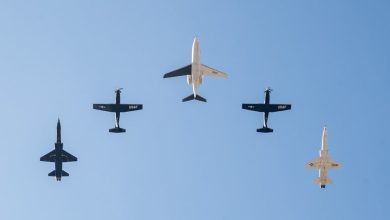DOD event challenges industry to down largest drone swarms to date

The joint office established to find solutions to countering air drone systems sought to challenge industry with large barrages of drone attacks during a demonstration in the Arizona desert last month.
“Although I can’t discuss at this time, the actual results of the demo, what I can say is the selected vendors did show increased maturity and awareness of the threat environment that U.S. allies are facing,” Col. Michael Parent, chief of the Joint Counter-small unmanned aircraft systems Office’s acquisition and resources division, told reporters in a recent briefing. “It was a very successful demonstration informing the U.S. and our allies what capabilities exist out there in a very challenging profile.”
The proliferation of drones on the battlefield is rising. For example, Ukraine is losing 10,000 per month while defending itself from Russian invaders, according to the Royal United Services Institute think tank. Flooding the battlefield with a large number of drones, especially those able to fly in a coordinated fashion, is a threat the U.S. military is still trying to address.
The joint office, also known as JCO, and the U.S. Army’s Rapid Capabilities and Critical Technologies Office, or RCCTO, chose eight industry teams and evaluated nine systems during a capability evaluation at Yuma Proving Ground over the month of June.
Whittled down from nearly 60 proposals, the eight companies chosen to bring systems were Clear Align; Trakka USA Defense; Ideas, Commitment, Results (ICR), Inc.; ELTA North America; Teledyne FLIR; Science Applications International Corporation (SAIC); Advanced Technology Systems Corporation (ATSC) and Anduril Industries.
Both non-kinetic and kinetic solutions were evaluated along with multi-mission radars, electro-optical/infrared cameras, radio frequency scanners and jammers, guided rockets, interceptor drones and small arms weapon systems, according to Parent.
The demonstration “was the most challenging demonstration to date at this point,” Parent said, with up to 50 air drone targets at a time, operated by a third party, coming from all directions and converging on a defended area. Drones in the swarms included rotary and fixed-wing aircraft — fast moving jets and slow-moving propeller-driven frames — and ranged from Group 1 drones weighing less than 20 pounds to Group 3 drones weighing less than 1,300 pounds.
Test scenarios were not shared with industry teams before the demonstration.
“The challenge of the profiles really meant that no one characteristic, no one capability, whether kinetic or non-kinetic, in itself could really defeat this kind of a profile,” Parent said. “So what we saw was that you really do need a full system-of-systems approach, a layered approach.”
The demonstration is the fifth of its kind. The Pentagon created the joint office in late 2019 and selected the Army to lead the organization. It is entirely focused on bringing counter-small drone capability into the force. The office’s first demonstration took place in the spring of 2021 and the second took place in the fall, followed by another in the spring of 2022, and then another in the summer of 2023.
In the first demonstration, the office looked at low-collateral interceptors to counter small drones; in the second demonstration, it examined cheap, ground-launched and hand-held capabilities; and in the third, it evaluated high-power microwaves as well as the concept known as counter-UAS as a service.
To address the challenging threat of one-way attack drones prominently seen in Ukraine over the past year, the office most recently tackled how to defeat them in a June demonstration at Yuma Proving Ground in Arizona.
As the demonstrations have evolved, Parent said he is seeing industry come with increasingly mature approaches.
“The vendors being selected in the demonstrations are having a better understanding of the threat that they must defeat, their command and control is better and you have a better understanding of what is required to operate in the environment,” Parent said. “We are seeing a much better capability from the vendors in actual solutions themselves as well.”
The solutions all showed better tracking, identification and defeat capabilities, he added.
Now the JCO is in the process of analyzing the data from the demonstration in order to inform individual vendors on performance and progress, according to Parent.
The JCO may determine more investment is required for a solution and could either choose to fund that effort or encourage industry teams to continue their own internal investment to reduce system risk, Parent said.
The services or combatant commanders could also choose to embark on a prototyping effort for a particular solution like the U.S. Army did, for example, with its Epirus-developed Leonidas High Power Microwave counter-drone solution, Parent noted.
Some solutions could be chosen for immediate acquisition, he added, because a solution showed enough maturity to address current or future threats.
The JCO is planning another demonstration between the second and third quarter of fiscal 2025. Additional details on the demonstration will be released within the fourth quarter of FY24.
Jen Judson is an award-winning journalist covering land warfare for Defense News. She has also worked for Politico and Inside Defense. She holds a Master of Science degree in journalism from Boston University and a Bachelor of Arts degree from Kenyon College.







